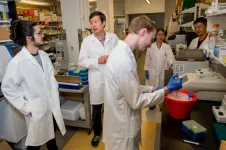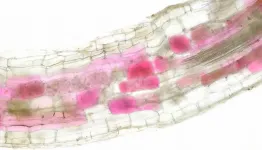Research identifies potential role of 'junk DNA' sequence in aging, cancer
2021-07-23
(Press-News.org) The human body is essentially made up of trillions of living cells. It ages as its cells age, which happens when those cells eventually stop replicating and dividing. Scientists have long known that genes influence how cells age and how long humans live, but how that works exactly remains unclear. Findings from a new study led by researchers at Washington State University have solved a small piece of that puzzle, bringing scientists one step closer to solving the mystery of aging.
A research team headed by Jiyue Zhu, a professor in the College of Pharmacy and Pharmaceutical Sciences, recently identified a DNA region known as VNTR2-1 that appears to drive the activity of the telomerase gene, which has been shown to prevent aging in certain types of cells. The study was published in the journal Proceedings of the National Academy of Sciences (PNAS).
The telomerase gene controls the activity of the telomerase enzyme, which helps produce telomeres, the caps at the end of each strand of DNA that protect the chromosomes within our cells. In normal cells, the length of telomeres gets a little bit shorter every time cells duplicate their DNA before they divide. When telomeres get too short, cells can no longer reproduce, causing them to age and die. However, in certain cell types--including reproductive cells and cancer cells--the activity of the telomerase gene ensures that telomeres are reset to the same length when DNA is copied. This is essentially what restarts the aging clock in new offspring but is also the reason why cancer cells can continue to multiply and form tumors.
Knowing how the telomerase gene is regulated and activated and why it is only active in certain types of cells could someday be the key to understanding how humans age, as well as how to stop the spread of cancer. That is why Zhu has focused the past 20 years of his career as a scientist solely on the study of this gene.
Zhu said that his team's latest finding that VNTR2-1 helps to drive the activity of the telomerase gene is especially notable because of the type of DNA sequence it represents.
"Almost 50% of our genome consists of repetitive DNA that does not code for protein," Zhu said. "These DNA sequences tend to be considered as 'junk DNA' or dark matters in our genome, and they are difficult to study. Our study describes that one of those units actually has a function in that it enhances the activity of the telomerase gene."
Their finding is based on a series of experiments that found that deleting the DNA sequence from cancer cells--both in a human cell line and in mice--caused telomeres to shorten, cells to age, and tumors to stop growing. Subsequently, they conducted a study that looked at the length of the sequence in DNA samples taken from Caucasian and African American centenarians and control participants in the Georgia Centenarian Study, a study that followed a group of people aged 100 or above between 1988 and 2008. The researchers found that the length of the sequence ranged from as short as 53 repeats--or copies--of the DNA to as long as 160 repeats.
"It varies a lot, and our study actually shows that the telomerase gene is more active in people with a longer sequence," Zhu said.
Since very short sequences were found only in African American participants, they looked more closely at that group and found that there were relatively few centenarians with a short VNTR2-1 sequence as compared to control participants. However, Zhu said it was worth noting that having a shorter sequence does not necessarily mean your lifespan will be shorter, because it means the telomerase gene is less active and your telomere length may be shorter, which could make you less likely to develop cancer.
"Our findings are telling us that this VNTR2-1 sequence contributes to the genetic diversity of how we age and how we get cancer," Zhu said. "We know that oncogenes--or cancer genes--and tumor suppressor genes don't account for all the reasons why we get cancer. Our research shows that the picture is a lot more complicated than a mutation of an oncogene and makes a strong case for expanding our research to look more closely at this so-called junk DNA."
Zhu noted that since African Americans have been in the United States for generations, many of them have Caucasian ancestors from whom they may have inherited some of this sequence. So as a next step, he and his team hope to be able to study the sequence in an African population.
INFORMATION:
In addition to Zhu, authors on the paper include co-first authors Tao Xu and De Cheng and others at Washington State University, as well as their collaborators at Northeast Forestry University in China; Pennsylvania State University; and North Carolina State University.
Funding for this study came from the National Institutes of Health's National Institute of General Medical Sciences, the Melanoma Research Alliance, and the Health Sciences and Services Authority of Spokane County.
[Attachments] See images for this press release:

ELSE PRESS RELEASES FROM THIS DATE:
2021-07-23
Almost all crop plants form associations with a particular type of fungi - called arbuscular mycorrhiza fungi - in the soil, which greatly expand their root surface area. This mutually beneficial interaction boosts the plant's ability to take up nutrients that are vital for growth.
The more nutrients plants obtain naturally, the less artificial fertilisers are needed. Understanding this natural process, as the first step towards potentially enhancing it, is an ongoing research challenge. Progress is likely to pay huge dividends for agricultural productivity.
In a study published in the journal PLOS Biology, researchers used the bright red pigments of beetroot - called betalains - to visually track soil fungi as they colonised plant roots in a living plant.
"We can now ...
2021-07-23
Many disease-causing bacteria such as Pseudomonas aeruginosa crawl on surfaces through a walk-like motility known as "twitching". Nanometers-wide filaments called type IV pili are known to power twitching, but scientists ignore which sensory signals coordinate the microbes' movements.
Now, EPFL researchers have found that Pseudomonas bacteria use a mechanism similar to our sense of touch to navigate on surfaces. "This study changes the way we think about motility in bacteria," says senior author Alexandre Persat, a tenure track assistant professor at EPFL's School of Life Sciences.
Scientists have known that ...
2021-07-23
Oncotarget published "Role for Fgr and Numb in retinoic acid-induced differentiation and G0 arrest of non-APL AML cells" which reported that retinoic acid is a fundamental regulator of cell cycle and cell differentiation.
Using a leukemic patient-derived in vitro model of a non-APL AML, these authors previously found that RA evokes activation of a macromolecular signaling complex, a signalosome, built of numerous MAPK-pathway-related signaling molecules; and this signaling enabled Retinoic-Acid-Response-Elements to regulate gene expression that results in cell differentiation/cell cycle arrest. Toward mechanistic ...
2021-07-23
Researchers from George Mason University, University of Manitoba, Colorado State University, and Georgetown University published a new paper in the Journal of Marketing that examines an unintended customer consequence of lobbying, decreased customer satisfaction, and also explains marketing-focused efforts that can help prevent it.
The study, forthcoming in the the Journal of Marketing, is titled "Shedding Light on the Dark Side of Firm Lobbying: A Customer Perspective" and is authored by Gautham Vadakkepatt, Sandeep Arora, Kelly Martin, and Neeru Paharia.
Lobbying, ...
2021-07-23
A network of over 100 herbaria spread out across the southeastern United States recently completed the herculean task of fully digitizing more than three million specimens collected by botanists and naturalists over a span of 200 years. The project, which was funded by the National Science Foundation, is part of a larger, ongoing effort by natural history institutions worldwide to make their biological collections easily accessible to researchers studying broad patterns of evolution, extinction, range shifts, and climate change.
In a END ...
2021-07-23
A team at the Natural History Museum (NHM), London is paving the way for future rovers to search for meteorites on Mars. The scientists are using the NHM's extensive meteorite collection to test the spectral instruments destined for the ExoMars rover Rosalind Franklin, and develop tools to identify meteorites on the surface of the red planet. The project is being presented today (23 July) at the virtual National Astronomy Meeting 2021.
The cratered surface of our nearest planetary neighbour has a long and complex history, and searching for rocks amidst more rocks may seem like a futile activity. Despite this, Martian rovers statistically have a significantly higher 'find per mile' success rate than dedicated meteorite hunts on ...
2021-07-23
The first clinical trial of a new dietary treatment for children and adults with severe forms of epilepsy, co-developed by UCL researchers and based on the ketogenic diet, has been successfully completed.
For the study, published in Brain Communications, clinicians evaluated the use of K.Vita®, (also known as Betashot), an oral liquid dietary supplement developed by UCL in collaboration with Royal Holloway, University of London, and Vitaflo International Ltd.
The ketogenic diet (KD) consists of high-fat, low-carbohydrate and adequate protein consumption and mimics the fasting state, altering the metabolism to use body fat as the primary fuel source. This switch from carbohydrates to fat for body ...
2021-07-23
A dust storm that engulfed Mars in 2018 destroyed a vortex of cold air around the planet's south pole and brought an early spring to the hemisphere. By contrast, the storm caused only minor distortions to the polar vortex in the northern hemisphere and no dramatic seasonal changes. Dr Paul Streeter of The Open University's Faculty of Science, Technology, Engineering and Mathematics will present the work today (23 July) at the virtual National Astronomy Meeting (NAM 2021).
Over two weeks at the beginning of June 2018, localised dust storms combined and spread to form an impenetrable blanket of dust that hid almost the entire planet's surface. The global dust storm, ...
2021-07-23
CHAPEL HILL, North Carolina--Researchers at the UNC Lineberger Comprehensive Cancer Center demonstrated in a clinical trial in Malawi that a five-drug combination chemotherapy provided curative benefit compared to current standard-of care-therapy in people diagnosed with lymphoma, and now they have determined this option is also cost-effective. The economic finding appeared July 22, 2021, in Lancet Global Health.
The clinical trial results, reported May 19, 2021, in Lancet Global Health involved 37 people with diffuse large B-cell lymphoma (DLBCL). ...
2021-07-23
CHAPEL HILL, North Carolina--A new study has demonstrated that patients with advanced bladder cancers whose tumors have a mutated FGFR3 gene respond to immunotherapy treatment in a manner that is similar to patients without that mutation, a discovery that runs counter to previous assumptions. This research, led by scientists at the University of North Carolina Lineberger Comprehensive Cancer Center, has important implications for patients who have not been offered immunotherapy because of their genetic profiles.
The findings are published in the British Journal of Cancer.
The National Cancer Institute estimates that 83,730 people in the United States will be diagnosed with bladder cancer in 2021, and the disease will cause 17,200 deaths. While the cancer ...
LAST 30 PRESS RELEASES:
[Press-News.org] Research identifies potential role of 'junk DNA' sequence in aging, cancer






